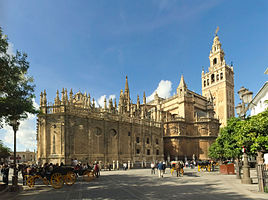
Back Sevilla ACE Sevilla Afrikaans Sevilla ALS ሰቪያ Amharic Sevilla AN Hispalis ANG إشبيلية Arabic سيڤييا ARY سيبييا ARZ Sevilla AST
Seville
Sevilla | |
|---|---|
| Motto: NO8DO ([Ella] No me ha dejado – [She] has not abandoned me) | |
 Location of Seville | |
| Coordinates: 37°23′24″N 5°59′24″W / 37.39000°N 5.99000°W | |
| Country | |
| Autonomous Community | |
| Province | Seville |
| Government | |
| • Type | Ayuntamiento |
| • Body | Ayuntamiento de Sevilla |
| • Mayor | José Luis Sanz (PP) |
| Area | |
| • Municipality | 140 km2 (50 sq mi) |
| Elevation | 7 m (23 ft) |
| Population (2021) | |
| • Municipality | 684,234 |
| • Rank | 4th |
| • Density | 4,900/km2 (13,000/sq mi) |
| • Urban | 1,100,000[1] |
| • Metro | 1,519,639 |
| Demonym(s) | Sevillan, Sevillian sevillano (m.), sevillana (f.) hispalense |
| GDP | |
| • Metro | €36.785 billion (2020) |
| Time zone | UTC+1 (CET) |
| • Summer (DST) | UTC+2 (CEST) |
| Postcode | 41001–41020, 41070–41071, 41080, 41092 |
| Website | www |
Seville (/səˈvɪl/ sə-VIL; Spanish: Sevilla, pronounced [seˈβiʎa] ⓘ) is the capital and largest city of the Spanish autonomous community of Andalusia and the province of Seville. It is situated on the lower reaches of the River Guadalquivir, in the southwest of the Iberian Peninsula.
Seville has a municipal population of about 701,000 as of 2022[update], and a metropolitan population of about 1.5 million, making it the largest city in Andalusia, the fourth-largest city in Spain and the 26th most populous municipality in the European Union. Its old town, with an area of 4 square kilometres (2 sq mi), contains a UNESCO World Heritage Site comprising three buildings: the Alcázar palace complex, the Cathedral and the General Archive of the Indies. The Seville harbour, located about 80 kilometres (50 miles) from the Atlantic Ocean, is the only river port in Spain.[3] The capital of Andalusia features hot temperatures in the summer, with daily maximums routinely above 35 °C (95 °F) in July and August.
Seville was founded as the Roman city of Hispalis. Known as Ishbiliyah after the Islamic conquest in 711, Seville became the centre of the independent Taifa of Seville following the collapse of the Caliphate of Córdoba in the early 11th century; later it was ruled by Almoravids and Almohads until being incorporated to the Crown of Castile in 1248.[4] Owing to its role as gateway of the Spanish Empire's trans-atlantic trade, managed from the Casa de Contratación, Seville became one of the largest cities in Western Europe in the 16th century. Coinciding with the Baroque period, the 17th century in Seville represented the most brilliant flowering of the city's culture. Following a deterioration in drought conditions in the Guadalquivir, the American trade gradually moved away from the city of Seville, in favour initially of downstream-dependent berths and eventually of the Bay of Cádiz - to which were eventually transferred control of both the fleets of the Indies (1680) and the Casa de Contratación (1717).[5]
The 20th century in Seville saw the tribulations of the Spanish Civil War, decisive cultural milestones such as the Ibero-American Exposition of 1929 and Expo '92, and the city's election as the capital of the Autonomous Community of Andalusia.
- ^ Demographia: World Urban Areas, 2022
- ^ "Gross domestic product (GDP) at current market prices by metropolitan regions". ec.europa.eu.
- ^ Staff (2020). "Seville, Spain". earth.esa.int. ESA Earth Online 2000 - 2020. Archived from the original on 21 March 2020. Retrieved 21 March 2020.
- ^ Christian-Muslim Relations. A Bibliographical History. Volume 4 (1200–1350). Brill. 2012. p. 9. ISBN 978-90-04-22854-2. Retrieved 7 February 2013.
- ^ Pachecho Morales-Padrón, Marcos (2021). "La organización portuaria del golfo de Cádiz en los siglos XVI y XVII: el Arenal de Sevilla y sus antepuertos". Chronica Nova. 47. Granada: Editorial Universidad de Granada: 430–431. doi:10.30827/cnova.v0i47.7672. ISSN 0210-9611.
© MMXXIII Rich X Search. We shall prevail. All rights reserved. Rich X Search







